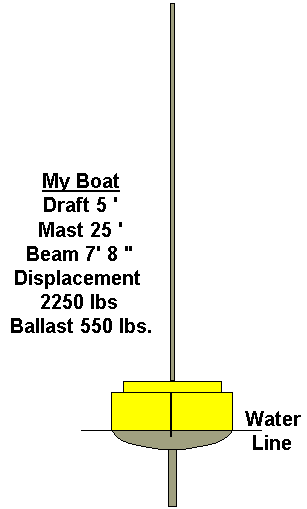
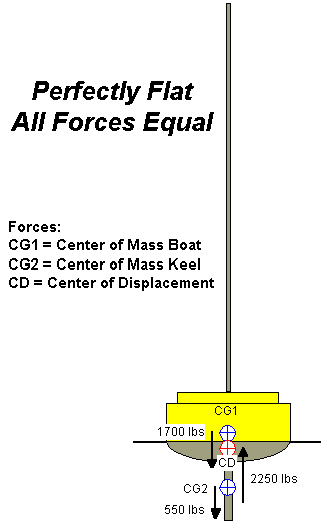
| Ballast (bal' est) (noun) Nautical 1. any heavy material carried in a ship to provide desired draft and stability. |
Sailboats have ballast designed into them in order to resist the rotating effect, known as 'heeling', caused by the wind's forces on the sails. Resistance to heeling gives the boat stability, and the ability to right itself after being 'knocked down' by the wind.
The stability of a sailboat is a result of its ballast; and with sailboats there are two types of stability - Intial Stability and Ultimate Stability. Initial stability is a boat's resistance to heeling in the early stages of the heeling process (less than 15 degrees), and ultimate stability is a boat's resistance to heeling in the final stages of the process (approaching 90 degrees). The mechanics of Initial and Ultimate stability are different, and there is a transition from Initial stability to Ultimate stability as the heeling angle increases.
| Heel (Heel') (verb) Nautical 1. to cause to lean to one side. 2. to cause to lean, tilt, or cant. |
Heeling is an inevitable result of wind pressure on the sails. All sailboats heel to some extent while underway. My normal crew, being somewhat new to sailing, is not that comfortable with the sensation of heeling. Many people new to sailing find it uncomfortable at first; it takes a little getting used to.
Heeling is not a problem unless it becomes excessive. A well-tuned boat will tend to round-up into the wind, if it heels excessively. Often, to check the tuning of my boat, I will allow it to heel over and see that it gradually turns into the wind. The turning then reduces the angle at which the sails meet the wind, and the heeling force is reduced. If too strong a gust is encountered, a boat can heel way over before it has a chance to round-up.
My boat is somewhat lightly ballasted, having only 24% of its overall weight as ballast. More heavily ballasted boats will have 30% and even as high as 40% of their overall weight as ballast. I have noticed that many smaller boats have lower ballast ratios, which they can get away with, as the crew can position themselves on the windard side of the boat to counter-act heeling. The position of the crew has less of an impact on bigger boats, therefore, they tend to have higher ballast ratios.
Boats that have lower resistance to heeling are referred to as 'tender' and likewise, boats with significant resistance to heeling are referred to as 'stiff'. Based on my experience so far, I would say that my boat (Catalina 22) is somewhere in the middle between tender and stiff.
I have become curious about the ballast on my boat and its impact on heeling. Given that the ballast ratio is somewhat low, perhaps I could add ballast to improve the boat's overall stability and performance. In order to demonstrate the effects of ballast and heeling on my boat, and evaluate any potential changes, I created the following scale diagrams below, using "Visio" software. The analysis is certainly not perfect, and I have ignored some of the other factors that effect heeling for simplicity sake. Overall, I think it generally demonstrates the mechanics involved. I can use these diagrams to determine the impact of adding ballast to my boat.
 |
 |
| The diagram of my Catalina 22. | Everything is in happy equilibrium. The weight of the boat and ballast (as separate components CG1 & CG2) and the opposing force of water displacement (CD). |
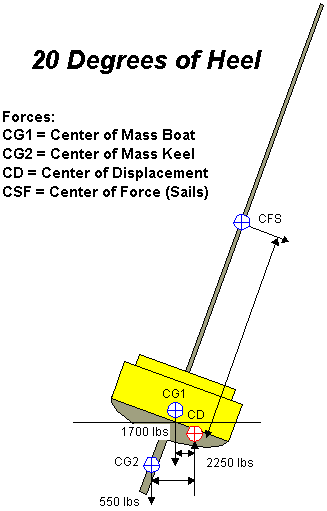 |
The early stages of heeling
- As the boat heels to leeward, the center of
displacement moves to the leeward side as well. The
resistance to heeling is provided by the center of
gravity offset of the boat and keel (CG1 & CG2)
versus the new center of displacement (CD). The shape of
the hull contributes to how much the center
of displacement will move as the boat heels;
i.e. the boat's Initial Stability. Boats with
a 'hard chine' have higher Initial Stability.
Consider hypothetically, a boat that had a
perfectly round hull. It would have no Initial
Stability and need to rely on its Ultimate Stability for
righting moment. Since I know the weight of the basic
components of the boat and the relative dimensions, I can
figure out the force on the sails and the righting moment
required at 20 degrees of heel. (The Visio software that
I used to create these diagrams gave me the dimensions
that I use in the formulas) The math: for GC1: (1.25 ft x 1700 lbs) = 2125 ft-lbs for CG2: (2.75 ft x 550 lbs) = 1512 ft-lbs Total torque = (1512 + 2125) = 3637 ft-lbs This force is coming from the sails , so I can estimate the force on the sails by approximating how far up the mast the center of force (CFS) lies. (It is about 14 feet above the CD point). Force on the Mast (CFS) = (3637 ft-lbs / 14 ft) = 260 lbs This would indicate that if the boat is heeling 20 degrees, then there is about 260 lbs of lateral force on the mast coming from the sails. (for simplicity I have ignored the forward force on the mast from the sails as it would not effect heeling) |
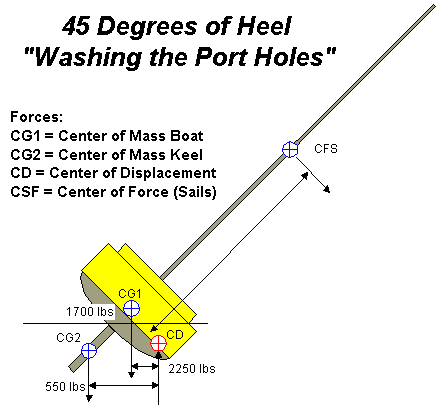 |
The
more advanced stages of heeling. The
center of displacement continues to move towards the
leeward side of the boat and the distance between the
three centers of weight/displacement increases. More Math: for CG1: (4.5 ft x 550 lbs) = 2475 ft-lbs for CG2: (1.75 ft x 1700 lbs) = 2975 ft-lbs Total torque = (2475 + 2975) = 5450 ft-lbs Force on the Mast: (5450 ft/lbs / 13.5 ft) = 404 lbs (wow!) Past 45 degrees of heel, the transistion can take place rather quickly . . . |
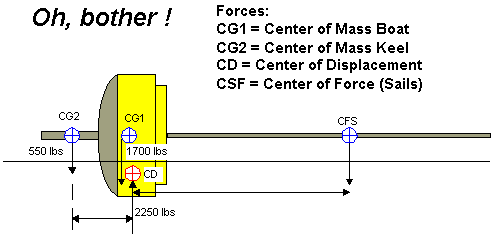 |
|
| The final process of heeling
- a knock down! The mast has rotated 90
degrees and is now parallel to the water. The center
of mass of the boat (CG1) is now approximately
in line with the center of displacement, providing
little/no righting moment. The righting moment in this
state (ultimate stability) is provided soley by the
weight of the ballast (CG2), in the keel. Math, again: for CG1: ( 0 ft x (1700 - 80) lbs) = 0 ft-lbs (!!!) for CG2: (4 ft X 550 lbs) = 2200 ft-lbs (Total Torque) Force on the mast (CFS) at this point would not be from the wind, but from the weight of the mast and sails (and perhaps water). I have not shown this mass separately in the previous diagrams, but I figure it to be about 80 lbs (assuming no water). Therefore the righting moment would be . . . Righting Moment = ((2200 ft-lbs) - (14 ft x 80 lbs)) = 1080 ft-lbs It would not take much additional force on the mast to prevent the boat from righting itself, as you can see by the following formula. . . (2200 ft-lbs / 14 ft) = 157 lbs . . . That is to say that a total weight of 157 lbs at mid-point along the mast will hold the boat in a knock-down position. Considering the mast & sails weigh about 80 lbs, then only an additional 77 lbs at the midpoint of the mast will keep the boat from righting itself. This is usually the problem in a knock-down or capsize situation. If crew members are hanging onto the rigging, then they can easily keep the boat from righting itself, leading to the next picture . . . |
|
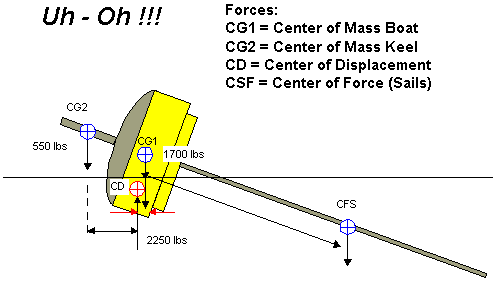 |
|
| Capsize ! - If the boat is
allowed to roll past 90 degrees (a capsize), the boat's
ability to right itself actually diminishes. Notice
in the diagram that the center of mass of the
boat (CG1) is on the leeward side of the center of
displacement (red arrows), promoting further rotation.
Only if the keel contains sufficient mass (ballast), will
the boat be able to right itself. Math: CG1: (-0.5 ft x 1700 lbs) = - 850 ft-lbs CG2: (3.25 ft x 550 lbs) = 1788 ft-lbs CFS: (-14 ft x 80 lbs) = -1120 ft-lbs Total torque = (-850 + 1788 - 1120 ) = - 182 ft-lbs A boat in this situation is 'in trouble' and will probably turn upside down ("turning turtle") unless the crew takes immediate action. Another issue that effects swing keel boats (like my Catalina 22) is the keel's tendency to retract as the boat rolls past 90 degrees. Most boat manufacturers have designed in locking pins (or bolts) to prevent/restrain the keel from retracting. |
|
Evaluating Additional Ballast
Based on the analysis of ballast and the heeling process of my Catalina 22, I can determine the probable effects of adding ballast to the boat. A few of interesting things to note from the analysis are . . .
Since my boat has a swing keel, I need to consider the extra load that additional ballast would place on the keel raising mechanism. Ideally, a relatively small amount of weight that would achieve the greatest righting moment would be the way to go.
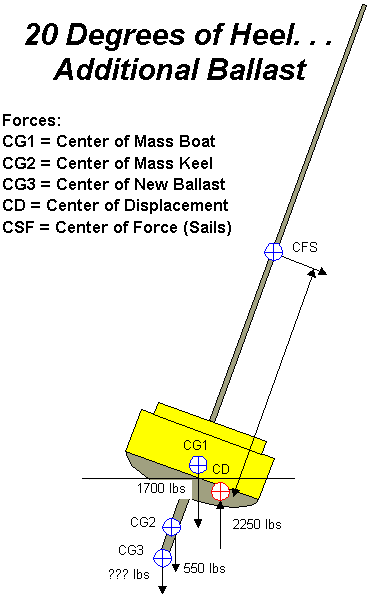 |
I
have considered adding 50, 100 or 150 lbs of ballast to
the bottom of the keel, and re-run the math according to
the diagram on the left. Although the addition of 150
lbs, and possibly 100 lbs of ballast at the end of the
keel may not be practical, I have included these weights
in the analysis for comparision purposes. From the 20 degree heeling diagram above . . . The math for 50 lbs additional: for GC1: (1.25 ft x 1700 lbs) = 2125 ft-lbs for CG2: (2.75 ft x 550 lbs) = 1512 ft-lbs for CG3: (3.25 ft x 50 lbs) = 163 ft-lbs Total torque = (1512 + 2125 + 162) = 3800 ft-lbs Force on the Mast = (3799 ft-lbs / 14 ft) = 271 lbs The math for 100 lbs additional: for CG3: (3.25 ft x 100 lbs) = 325 ft-lbs Total torque = (1512 + 2125 + 325) = 3962 ft-lbs Force on the Mast = (3962 ft-lbs / 14 ft) = 283 lbs The math for 150 lbs additional: for CG3: (3.25 ft x 150 lbs) = 488 ft-lbs Total torque = (1512 + 2125 + 488) = 4125 ft-lbs Force on the Mast = (4125 ft-lbs / 14 ft) = 295 lbs |
The addition of ballast would make the boat a bit stiffer (5 - 15%), as the figures indicate. The Ultimate stability would be improved by 575 ft-lbs of righting moment for every 100 lbs of added ballast. This would be a significant (50%) improvement in the righting moment at 90 degrees of heel. I have computed righting torque, mast force, and ballast ratios for the ballast weight increments (50, 100, 150 lbs) under consideration.
Ballast Calculations
Righting Torque (ft-lbs) |
Mast Force (lbs) |
|||||||
| Std Boat | 50 lbs more | 100 lbs more | 150 lbs more | Std Boat | 50 lbs more | 100 lbs more | 150 lbs more | |
| 20 degrees | 3637 | 3800 | 3962 | 4125 | 260 | 271 | 283 | 295 |
| 45 degrees | 5450 | 5713 | 5975 | 6238 | 404 | 423 | 443 | 462 |
| 90 degrees* | 2200 | 2488 | 2775 | 3063 | 157 | 178 | 198 | 219 |
| . | . | . | . | . | . | . | . | . |
| Total Ballast (lbs) | 550 | 600 | 650 | 700 | ||||
| Ballast/ Wgt. Ratio | 24.4% | 26.1% | 27.7% | 29.2% | ||||
* The 90 Degree figures do not include the weight of the mast, which would have to be subtracted from these figures.
Next spring, I will see if I can fabricate a wing or bulb out of lead that can be bolted to the end of the keel. By making a piece that can be bolted on, it could also be removed, so the boat could be sailed in class competition. I think it would be impractical (if not unwise) to add too much weight to the keel, as the support mechanisms were designed for a 550 lb. keel. I think that I will just to go with 50 lbs of added ballast, which will result in a 5-10% improvement.
Update: See my Keel Refurbishment page on how I added 50 lbs. of ballast to the end of my keel.